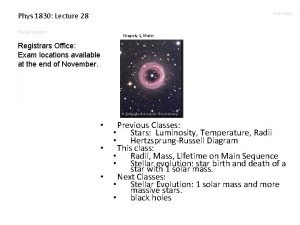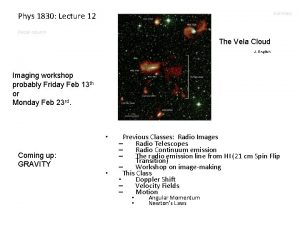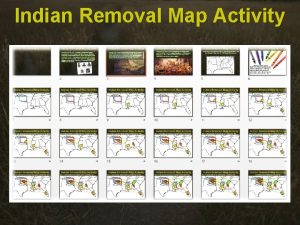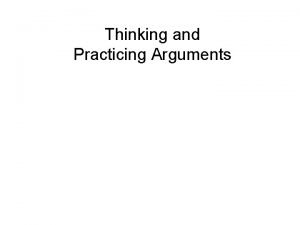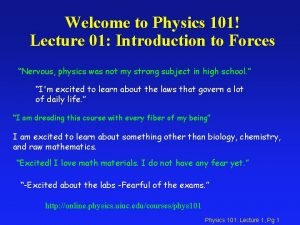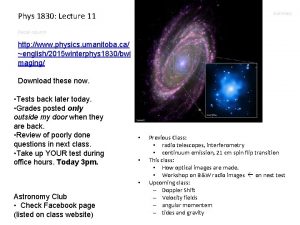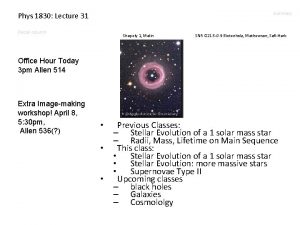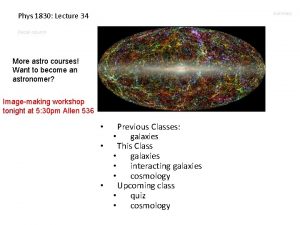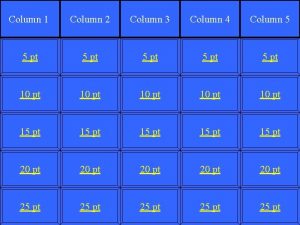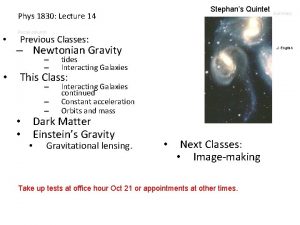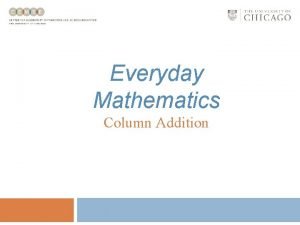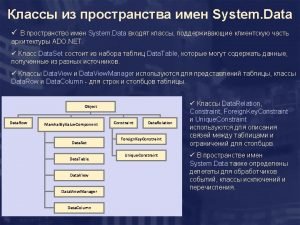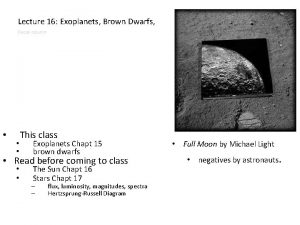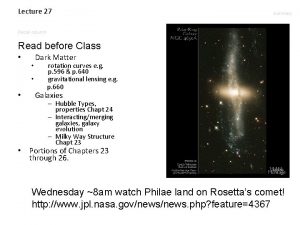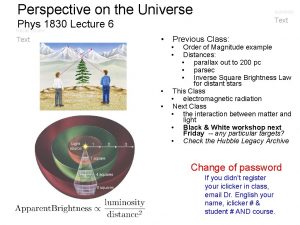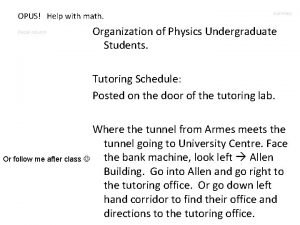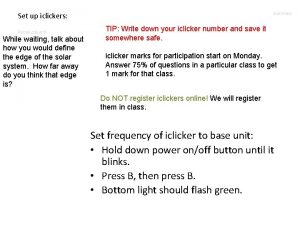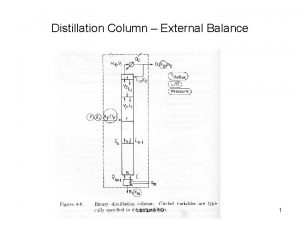summary Phys 1830 Lecture 32 Recall column Making































- Slides: 31

summary Phys 1830: Lecture 32 Recall column Making images! Wednesday April 8!!! 5: 30 pm Allen 536 SEEQ M 82 by Remi Lacasse Images from the workshop! http: //www. physics. umanito ba. ca/~english/2015 winterp hys 1830/bwimaging/image sindex. html Galactic wind i. e. fountain • Friday April 24 1: 30 pm Frank Kennedy Gold Gym Seats 1 -135 Password? • • Previous Classes: • Evolution of stars, 1 solar and massive. • Supernovae pulsars, This Class • Light echos • gamma-ray bursts • Black holes Upcoming classes • Galaxies – please review previous lectures • Cosmology.

Announcements w. r. t. Exam Recall column summary • 1 more Office Hour Mon 3: 00 pm Allen 514 • Contact me to see other times. – e. g. go over missed classes, review images • Exam: – 1: 30 -3: 30 pm Friday April 24 – Frank Kennedy Gold Gym seats 1 -135 – check Registrars’ website - about 70 questions – includes images – Pseudo-cumulative – doesn’t include planetarium exercise

Crab Nebula Movie summary Recall column • Left is x-ray. Right is visual. • Pulses 30 times a second. • Formed in 1054 A. D.

Supernova 1987 a summary Recall column • Discovered by UM alumnus Ian Shelton. The first SN in the year 1987. • First naked-eye SN in ~380 years. • Occurred in a neighbouring satellite galaxy called the Large Magellanic Cloud.

Recall giant stars eject their outer envelopes! Recall column • Slicing through the ejected shell. • Note spiral structure summary

SN 1987 a summary Recall column • The ring consists of material ejected from the progenitor star thousands of years before it blew up. • The brightening of the ring occurs as the blast from the supernova interacts with the ejected material.

Supernova light echo Recall column summary AAT; David Malin • Light from SN 1987 a interacts with dust in ISM. • Picture was made by photographically subtracting negative and positive images of plates of the region taken before and after the supernova appeared.

Supernova light echo CTIO/Super. Macho Team Recall column summary AAT; David Malin • • • Light moving outwards at constant speed. Consider the light paths not along our line of sight. Some of these intersect dust. The light is reflected off the dust into our telescopes. How the echo occurs for us on Earth can be derived using an ellipse with Earth at one focus and the SN at the other focus.

Supernova light echo Recall column summary Patrick Tisserand the EROS 2 collaboration • 1200 images from July 1996 to February 2002 (~6. 7 yrs) • Studies of light echos accurate positions and dates of explosions.

Review Recall column summary • A light echo is light from a sudden burst that is reflected off of material such as dust. It occurs sometime after the direct light from the burst is received. The photons have not been absorbed by the dust and re-emitted. a) True b) False

Long Gamma Ray Bursts: Super Duper Supernovae summary Recall column • High energy burst lasting longer than about 2 seconds. • GRB are observed ubiquitously over the sky at a rate of about 1 a day. • Have occurred simultaneously, at the same position, with SNe in galaxies. • Formation scenario: – Stellar mass greater than 25 -50 solar masses. – Core collapses to form a black hole! – Core produces relativistic jets which punch their way through the imploding star generating gamma rays.

Scientific American Diagram Recall column Short Burst Several scenariosrequres compact Merging neutron stars, Long Burst summary

What kind of star will blow up? summary Recall column • Roughly 100 solar masses gamma-ray burst. Actually a binary system. • Note the material ejected along the poles. • Roughly 7000 ly from Earth.

Eta Carina Simulations Recall column Watch at: http: //svs. gsfc. nasa. gov/cgi-bin/details. cgi? aid=11725 summary

What kind of stellar systems will blow up? summary V 445 Puppis: ESO Adaptive Optics Recall column • Double star system with bi-polar shells expanding at about 24 million kilometres per hour. • Changes in shell as some material from companion is accreted. • Recall one SN formation scenario is of white dwarfs merging. • Correct abundances of elements SN Type I

Review: summary Recall column a) b) • Which object above is most likely to form a black hole? a) Object in image a) b) Object in image b)

Review: summary Recall column a) SN 1 a progenitor b) SN II progentior • b) is likely to become a gamma-ray burst due to a black hole forming in its core.

Black holes: Recall column summary • Discuss with your neighbour what you think a black hole is: – How do they form? – What is their structure? – How do we detect them? – Can anything escape from them? – What is gravity like near them? Are they a cosmic vacuum cleaner or not? – What are their sizes? – Puzzles?

What do you believe? summary Recall column • Nothing can escape from a black hole. No energy of any kind, no matter of any kind. Therefore once a black hole forms it can grow larger, by matter falling in, but it can never shrink. a) True b) False

What do you believe? summary Recall column • A black hole is like a cosmic vacuum cleaner, sucking things into it from exceedingly large distances away. a) True b) False

Black Holes: Definition summary Recall column • A region of space-time where the gravitation becomes overwhelming and the curvature of space-time is so great that space “folds” over on itself.

Black Holes: Definition: Recall column summary Photon just outside a black hole. These also lose energy. • Escape velocity is equal to or greater than the speed of light. – The escape velocity is the energy of motion required to overcome gravity and go into orbit. Matter and light cannot escape.

Black Hole: components summary Recall column • Singularity: A point in the universe where the density of matter and the gravitational field are infinite. • Event Horizon: An imaginary spherical surface with a radius equal to the Schwarzschild radius, Rsch is the distance from the centre of an object such that, if all the mass were compressed within that region, the escape speed would equal the speed of light.

Recall GR Table Demo: Recall column summary • Hold rubber sheet up high – collapse 4 D spacetime into 2 D and embed in 3 D space to represent mathematics – GR reduces to Newton’s laws • A tennis ball gives a curve that generates gravitational pull wellrepresented by Newton’s laws. – nice orbits • Ball bearing on a handle represents dense object – Event Horizon plus curves described by Newton’s laws.

Black Hole: Components summary Recall column • Can also have: – Accretion disk – Jets – Magnetic field lines

Black Holes: Accretion Disk summary Recall column • Tidal forces stretch stars apart or a companion star’s outer layers flow towards the black hole. • The stellar material orbits in a disk. • Crashing into itself, the stellar gas loses energy and orbits closer and closer to the event horizon. • Some material falls through the Event Horizon while some particles travel along the magnetic field lines, creating bi-polar jets.

Black Holes: The size of the Event Horizon Recall column Only depends on mass! • M of Jupiter/ M of Sun = 2 * 10**27 kg/2 * 10**30 kg = 10**(27 -30) = 10 ** -3 solar masses. • Rsch of Jupiter ~ 3 km * 10**-3 = 3 * 10**3 m/km * 10**-3 =3 m i. e. roughly the height of a room. summary

Black Holes: summary Recall column If our Sun became a black hole right now, what would happen to the orbit of the Earth. a) Earth would get sucked into the black hole because black holes act like Cosmic Vacuum Cleaners. b) Nothing since the force of gravity doesn’t change until one is close to the event horizon.

Black Holes: Inside the Event Horizon Recall column summary • According to General Relativity, time isn’t a particularly special dimension. This means it can be swapped with another dimension. • Outside the event horizon you can move in any direction in space but only 1 direction in time (towards the future). • Inside the event horizon you can only move forward in space towards the singularity but you can move backwards and forwards in time!

Place a black hole between you and a star: summary Recall column Alain Riazuelo, IAP/UPMC/CNRS Also check out the “WIRED” article on “Interstellar” movie. • Note a very faint star in the middle of the image – place an intervening BH 2 images of the star. • Note the Milky Way and the Large Magellanic Cloud (LMC) • http: //antwrp. gsfc. nasa. gov/apod/ap 101207. html

Black Holes: Can anything escape a black hole? summary Recall column 1. E. g. Roger Blandford: Mechanical energy can escape. – Threaded through the gas, in the accretion disk and falling into the black hole, are magnetic field lines. – The lines twist around the rotating black hole, slowing it down. – The energy of rotation travels out along the lines and is deposited in the disk explains X-ray hot spots.
 Phys 241 lecture quizzes
Phys 241 lecture quizzes 10-column worksheet
10-column worksheet Recall column
Recall column Recall column
Recall column Recall column
Recall column Formula for slenderness ratio
Formula for slenderness ratio War making and state making as organized crime summary
War making and state making as organized crime summary 01:640:244 lecture notes - lecture 15: plat, idah, farad
01:640:244 lecture notes - lecture 15: plat, idah, farad Liberty leading the people, 1830
Liberty leading the people, 1830 Ensayos constitucionales de chile entre 1823 y 1830
Ensayos constitucionales de chile entre 1823 y 1830 Map of us in 1830
Map of us in 1830 Two complaints of tejanos in 1830
Two complaints of tejanos in 1830 Was andrew jackson a president
Was andrew jackson a president Five civilized tribes
Five civilized tribes Map of america 1830
Map of america 1830 Congressional act of 1830
Congressional act of 1830 Liberty leading the people, 1830
Liberty leading the people, 1830 Constitucion de ecuador 1830
Constitucion de ecuador 1830 5 i's of romanticism
5 i's of romanticism Emily dickinson (1830-1886)
Emily dickinson (1830-1886) I moti del 1830
I moti del 1830 Where did revolution spread in 1830
Where did revolution spread in 1830 þq
þq I moti del 1830-31
I moti del 1830-31 Liberty leading the people 1830
Liberty leading the people 1830 Indian removal act of 1830
Indian removal act of 1830 Candy crush 1830
Candy crush 1830 Indian removal act of 1830
Indian removal act of 1830 Språkdebatten 1830
Språkdebatten 1830 Uiuc phys 102
Uiuc phys 102 Taekjip
Taekjip Physics courses ucsd
Physics courses ucsd


